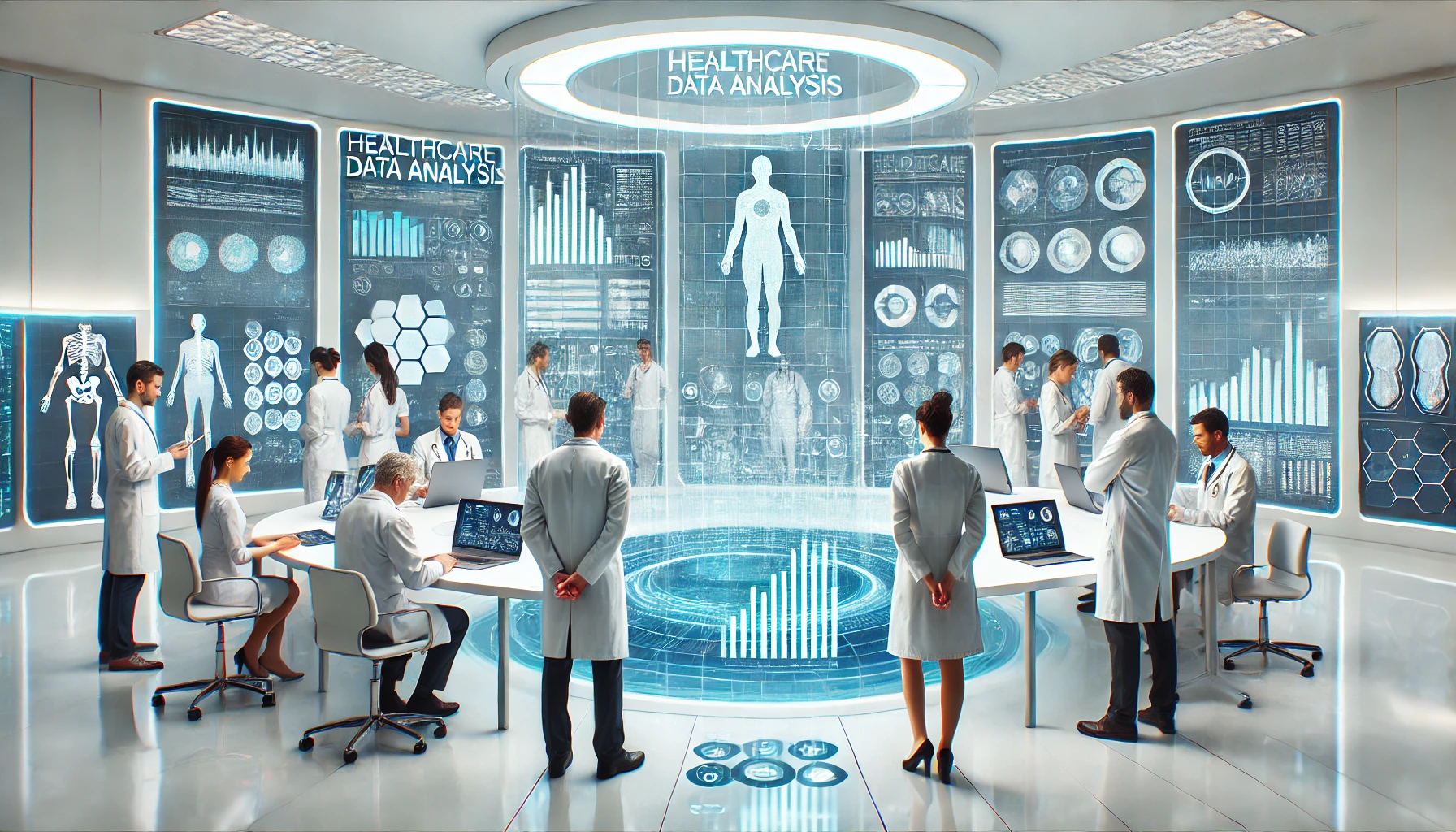You might be familiar with some common healthcare data analysis services, but have you truly explored the full spectrum of possibilities available to optimize patient care and operational efficiency? Understanding the intricacies of Electronic Health Records Analysis, Predictive Analytics, Patient Pathway Optimization, Healthcare Outcomes Improvement, Disease Pattern Analysis, and Healthcare Fraud Detection can revolutionize the way healthcare organizations operate. These services hold the key to unlocking hidden insights and enhancing decision-making processes in the ever-evolving landscape of healthcare data analysis.
Electronic Health Records Analysis
When analyzing electronic health records (EHRs), it is imperative to focus on the data-driven insights they provide. Utilizing data visualization techniques and data mining methods can uncover valuable information within EHRs. These techniques allow healthcare professionals to extract meaningful patterns and trends, aiding in the identification of population health insights and enhancing clinical decision support.
Data visualization techniques such as charts, graphs, and heat maps offer a clear and concise way to present complex EHR data. By visually representing patient information and health trends, healthcare providers can quickly identify patterns and outliers that may require further investigation. On the other hand, data mining methods like clustering and classification algorithms help in segmenting patient populations based on similarities, enabling targeted interventions and personalized care plans.
Predictive Analytics
Analyzing electronic health records provides a wealth of data that can be harnessed for predictive analytics. Predictive analytics in healthcare leverages this data to forecast trends, outcomes, and behaviors, aiding in proactive decision-making. Here are some key points to consider:
- Risk assessment: Predictive analytics can identify individuals at high risk for certain diseases or conditions based on their health history and demographics.
- Population health: By analyzing EHR data at a population level, healthcare providers can predict disease prevalence, allocate resources efficiently, and tailor interventions for better outcomes.
- Early intervention: Predictive analytics enables early identification of potential health issues, allowing for timely interventions and preventive measures.
- Personalized medicine: By predicting individual health trajectories, healthcare professionals can customize treatment plans and interventions according to each patient’s specific needs.
- Cost savings: Predictive analytics can help in reducing healthcare costs by optimizing resource allocation and preventive care strategies.
Patient Pathway Analysis
Conducting Patient Pathway Analysis involves tracing and analyzing the sequence of interactions a patient has with the healthcare system from initial contact to the conclusion of care. This analysis provides valuable insights into the patient journey, highlighting areas for improvement in care coordination and process optimization. By examining each step of the patient’s pathway, healthcare providers can identify bottlenecks, inefficiencies, or gaps in care delivery.
Care coordination is a key focus of Patient Pathway Analysis, aiming to ensure that all healthcare professionals involved in a patient’s care are working together seamlessly to provide the best possible outcome. Through this analysis, healthcare organizations can streamline processes, reduce unnecessary delays, and enhance the overall patient experience.
Process optimization is another critical aspect addressed by Patient Pathway Analysis. By identifying opportunities to improve workflows, resource allocation, and communication channels, healthcare providers can enhance the quality of care, reduce costs, and ultimately achieve better patient outcomes. Patient Pathway Analysis is a powerful tool in driving continuous improvement and delivering more efficient, patient-centered care.
Outcomes Analysis
Moving forward from understanding the patient journey through Patient Pathway Analysis, the focus now shifts to Outcomes Analysis. This aspect of healthcare data analysis delves into the results and impact of interventions on patient health and well-being. Outcomes Analysis plays a crucial role in guiding quality improvement initiatives and enhancing cost efficiency within healthcare systems.
Key Points to Consider:
- Benchmarking Outcomes: By comparing patient outcomes with established benchmarks, healthcare providers can identify areas for improvement and implement strategies to enhance quality of care.
- Tracking Key Performance Indicators: Monitoring specific outcome metrics allows for targeted interventions to improve patient outcomes and overall healthcare delivery.
- Predictive Modeling: Utilizing predictive analytics can help forecast potential outcomes, enabling proactive measures to be taken for better patient care.
- Resource Allocation: Analyzing outcomes data aids in optimizing resource allocation, ensuring cost efficiency while maintaining high-quality care.
- Continuous Evaluation: Regularly evaluating outcomes ensures ongoing quality improvement efforts and cost-effective healthcare delivery.
Disease Pattern Analysis
You can analyze disease patterns through trend identification methods, which help in understanding how certain illnesses evolve over time within a population. By utilizing predictive modeling techniques, you can forecast potential disease outbreaks and their impact, aiding in proactive healthcare planning. Implementing outbreak detection strategies allows for timely intervention and containment measures to mitigate the spread of diseases in communities.
Trend Identification Methods
Analyzing disease patterns is a crucial aspect of healthcare data analysis services. To identify trends effectively, various techniques are utilized:
- Data Visualization Techniques: Visual representations like charts and graphs help in spotting trends quickly.
- Trend Forecasting: Predictive analysis aids in foreseeing potential disease outbreaks or prevalence shifts.
- Data Mining Methods: Extracting valuable insights from vast datasets is crucial for trend identification.
- Pattern Recognition: Recognizing recurring patterns in data can lead to the discovery of significant trends.
- Statistical Analysis: Utilizing statistical tools to analyze patterns and trends in healthcare data is essential for informed decision-making.
Predictive Modeling Techniques
To effectively anticipate and address disease patterns in healthcare data analysis services, predictive modeling techniques play a pivotal role. These techniques encompass various methods such as risk assessment and forecasting trends to provide valuable insights for healthcare professionals. By analyzing historical data and current trends, predictive modeling helps in identifying patterns that can indicate potential health risks within populations. Through risk assessment, these models can predict the likelihood of specific diseases occurring in different demographics, enabling proactive measures to be taken.
Forecasting trends using predictive modeling allows healthcare providers to allocate resources effectively and implement preventive strategies to mitigate the impact of diseases. By understanding how certain factors influence the spread or occurrence of diseases, healthcare organizations can tailor their interventions to specific needs. Utilizing predictive modeling techniques not only enhances decision-making processes but also contributes to improving overall health outcomes by enabling timely and targeted interventions.
Outbreak Detection Strategies
Detecting and responding swiftly to disease outbreaks is a critical aspect of healthcare data analysis services. When it comes to outbreak detection strategies, utilizing early warning systems and robust surveillance systems is essential. Here are some key points to consider:
- Early Warning: Implementing algorithms that can detect unusual spikes in diseases before they turn into full-blown outbreaks.
- Surveillance System: Utilizing advanced surveillance systems to monitor trends, symptoms, and geographical locations of reported cases.
- Data Integration: Ensuring seamless integration of data sources to provide a comprehensive view of potential outbreaks.
- Predictive Analytics: Leveraging predictive analytics to forecast potential outbreaks based on historical data and current trends.
- Real-time Monitoring: Establishing real-time monitoring capabilities to track the progression of outbreaks and facilitate immediate response.
Healthcare Fraud Detection
When it comes to detecting healthcare fraud, various techniques are employed to analyze data effectively. Data analytics applications play a crucial role in identifying anomalies and patterns that may indicate fraudulent activities. Moreover, staying updated on regulatory compliance requirements is essential for ensuring the accuracy and legality of fraud detection practices.
Fraud Detection Techniques
A key aspect of healthcare data analysis services is the implementation of advanced fraud detection techniques to safeguard against fraudulent activities within the healthcare industry. By utilizing sophisticated algorithms and machine learning models, organizations can effectively identify and prevent fraudulent behavior. Two key methodologies employed in fraud detection are anomaly detection and patterns recognition.
- Anomaly Detection: This technique focuses on identifying outliers or unusual activities that deviate from normal behavior patterns.
- Patterns Recognition: By analyzing historical data, algorithms can recognize patterns indicative of fraudulent activities.
- Predictive Modeling: Utilizing historical data to predict future fraudulent behavior.
- Social Network Analysis: Examining relationships between entities to uncover complex fraud schemes.
- Real-Time Monitoring: Constantly monitoring transactions and activities in real-time to detect and prevent fraud as it occurs.
Implementing these fraud detection techniques can significantly reduce financial losses and protect the integrity of healthcare systems.
Data Analytics Applications
Healthcare fraud detection is a critical component of data analytics applications in the healthcare industry. Utilizing data visualization techniques, such as charts and graphs, can help in identifying patterns that may indicate fraudulent activities. By employing advanced data interpretation strategies, such as anomaly detection algorithms, statistical analysis, and machine learning models, healthcare organizations can sift through vast amounts of data to pinpoint irregularities that suggest potential fraud.
Effective data visualization techniques allow analysts to present complex information in a visually appealing and easily understandable format. This aids in identifying trends and outliers that could signify fraudulent behavior. Moreover, implementing data interpretation strategies enables healthcare providers to delve deeper into their data, uncovering hidden patterns and anomalies that may not be apparent at first glance.
Regulatory Compliance Requirements
Regulatory compliance requirements play a crucial role in ensuring the effectiveness of healthcare fraud detection efforts. To combat fraudulent activities effectively, healthcare organizations must adhere to stringent regulations and standards. Here are some key aspects to consider:
- Privacy Protection Measures: Implement robust protocols to safeguard patient data and ensure confidentiality.
- Compliance Auditing Procedures: Regularly assess internal processes to guarantee adherence to regulatory requirements.
- Training and Education: Provide comprehensive training to staff members on compliance protocols and fraud detection techniques.
- Documentation and Reporting: Maintain thorough documentation of all activities and promptly report any suspicious incidents.
- Continuous Monitoring: Regularly monitor systems and processes to identify any anomalies or irregularities that may indicate fraudulent behavior.
Frequently Asked Questions
How Can Healthcare Data Analysis Improve Patient Satisfaction Levels?
To enhance patient satisfaction, implement data-driven strategies for quality improvement. Engage patients in their care by analyzing performance metrics. By utilizing data effectively, you can identify trends, personalize care, and address issues promptly, ultimately boosting satisfaction levels.
What Are the Key Challenges in Implementing Predictive Analytics in Healthcare?
Implementing predictive analytics in healthcare presents challenges with data privacy compliance and the complexity of machine learning algorithms. Ensuring patient information security while leveraging advanced analytical techniques is crucial for successful adoption and utilization.
How Does Patient Pathway Analysis Contribute to Improving Healthcare Delivery?
By analyzing patient pathways, you can enhance resource allocation and optimize processes in healthcare delivery. Understanding how patients move through the system helps identify inefficiencies, improve care coordination, and ultimately enhance the quality of services provided.
What Are the Factors Influencing Outcomes Analysis in Healthcare Data?
To effectively analyze healthcare data outcomes, factors like data quality and technology integration play crucial roles. Ensuring accurate and reliable data and seamlessly integrating technologies improve the precision and efficiency of outcomes analysis in healthcare data.
How Can Healthcare Fraud Detection Systems Adapt to Evolving Fraudulent Tactics?
Adapting fraud prevention systems to evolving tactics involves leveraging machine learning for detection. Enhancing data accuracy through anomaly detection ensures timely identification of fraudulent activities. Stay ahead of fraudsters by continually updating algorithms and monitoring patterns.




